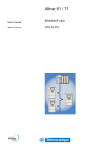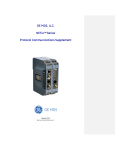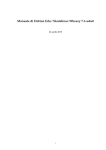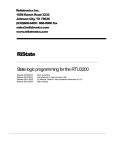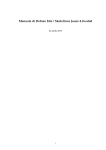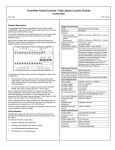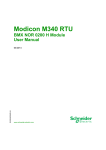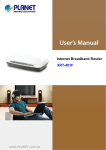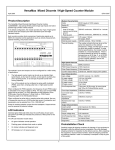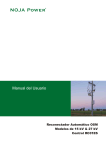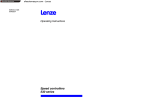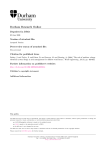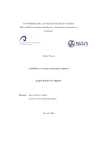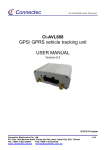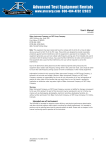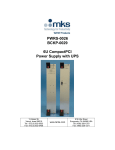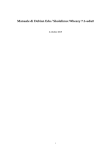Download NOJA Power
Transcript
NOJA-519 NOJA Power DNP3 Protocol Implementation NOJA-519 Revision History Rev Author Date Comment Draft BOS 14-7-03 Draft release of DNP3 Protocol Manual. Release BOS 10-9-03 First release of DNP3 Protocol Manual. Rev 02 BOS 19-5-04 Added SCADA port settings. Rev 03 BOS 2-11-04 Added Binary Input, Binary Output and Analog Input Points. Updated SCADA Settings section to reflect new MPM and TELUS functionality. Rev 04 KL 27-09-2006 Add logo. Rev 05 OS 29-03-2007 Added Calls Failed to SCADA Counters. Rev 06 BOS 18-06-09 Added new binary input points. Rev 07 BOS 22-01-10 Added new Binary Input, Binary Counters and Analog Input points. Source: S:\Marketing-500\User Manuals\SCADA Protocols\NOJA-519.doc This document is copyright and is intended for users and distributors of NOJA Power Switchgear product. It contains information that is the intellectual property of NOJA Power Switchgear and the document, or any part thereof, should not be copied or reproduced in any form without written permission from NOJA Power Switchgear. NOJA Power is a trademark of NOJA Power Switchgear and should not be reproduced or used in any way without written authorisation. NOJA Power Switchgear applies a policy of ongoing development and reserves the right to change product without notice. NOJA Power Switchgear does not accept any responsibility for loss or damage incurred as a result of acting or refraining from action based on information in this User Manual. © NOJA Power Switchgear Pty Ltd 2010 NOJA-519 Contents 1 INTRODUCTION ...............................................................................................................................................1 1.1 Applicability.............................................................................................................................................1 2 DNP V3.00 DEVICE PROFILE..........................................................................................................................2 3 DNP3 ELEMENTS STRUCTURE .....................................................................................................................5 3.1 DNP3 Objects structure .........................................................................................................................5 3.2 SCADA Settings ......................................................................................................................................5 4 IMPLEMENTATION TABLE .............................................................................................................................6 5 INTERNAL INDICATIONS ..............................................................................................................................11 6 BUFFER SIZE .................................................................................................................................................12 7 DNP3 SETTINGS ............................................................................................................................................13 8 DNP3 COUNTER DISPLAY............................................................................................................................17 8.1 DNP3 counter list ..................................................................................................................................17 9 SCADA SETTINGS .........................................................................................................................................18 9.1 Port Settings .........................................................................................................................................18 9.2 Radio Settings.......................................................................................................................................19 9.3 Modem Settings ....................................................................................................................................20 9.4 SCADA Time Configuration .................................................................................................................21 10 BINARY INPUT POINTS.................................................................................................................................22 11 BINARY OUTPUT POINTS.............................................................................................................................27 12 BINARY COUNTERS......................................................................................................................................29 13 ANALOG INPUT POINTS ...............................................................................................................................32 14 OCTET STRING OBJECTS ............................................................................................................................36 NOJA-519 Abbreviations IED - Intelligent Electronic Device RTS - Request To Send modem line SBO - Select Before Operate RBE - Report By Exception CROB - Control Relay Output Block NOJA-519 1 INTRODUCTION This DNP3 protocol implementation is fully compliant with DNP3 Subset Definition Level 2, contains many Subset Level 3 features and contains some functionality beyond Subset Level 3. Functionality included in this implementation is based on the Triangle MicroWorks, Inc. Slave Source Code Library except for the following objects: Short Floating Point Analog representation; Obj30, var5; Obj32, var5, var7; Obj34, var3; Obj40, var3; Obj41 var3 1.1 Long Floating Point Analog representation; Obj30, var6; Obj32, var6, var8; Obj40, var4; Obj41 var4 Analog Output Points Obj40, all variations; Obj41, all variations Sequential File Transfer Obj 70, all variations Virtual Terminal Objects Obj 112, Obj 113 Applicability This manual describes the DNP3 Protocol Implementation for MPM software versions from S02.03.04, build number 7335 onwards. If you have a software version earlier then this then this document does not apply. Please contact your NOJA Power representative for further information. The software version and build number can be read from the MPM LCD screen by navigating to the Identification screen as described in the recloser user manual. DNP3 Protocol Implementation Introduction 1. NOJA-519 2 DNP V3.00 DEVICE PROFILE The following table provides a “Device Profile Document” in the standard format defined in the DNP3 Subset Definitions Document. While it is referred to in the DNP3 Subset Definitions as a “Document,” it is only a component of a total interoperability guide. This table, in combination with the following provides a complete interoperability / configuration guide Implementation Table, section 4 Description of configuration methods and user-interface, section 7 Point List Tables, sections 10, 11, 12, 13 and 14. Table 2.1 DNP V3.00 DEVICE PROFILE DOCUMENT (Also see the Implementation Table) Vendor Name: NOJA Power Switchgear Device Name: Recloser Control (RC), using the Triangle MicroWorks, Inc. DNP3 Multi-Port Slave Source Code Library, version 3.00. Highest DNP Level Supported: Device Function: For Requests: Level 3 Master For Responses: Level 3 Slave Notable objects, functions, and/or qualifiers supported in addition to the Highest DNP Levels Supported (the complete list is described in the attached table): For static (non-change-event) object requests, request qualifier codes 00 and 01 (start-stop), 07 and 08 (limited quantity), and 17 and 28 (index) are supported in addition to request qualifier code 06 (no range – or all points). Static object requests received with qualifiers 00, 01, 06, 07, or 08, will be responded with qualifiers 00 or 01. Static object requests received with qualifiers 17 or 28 will be responded with qualifiers 17 or 28. For change-event object requests, qualifiers 17 or 28 are always responded. 16-bit and 32-bit Analog Change Events with Time are supported. The read function code for Object 50 (Time and Date), variation 1, is supported. Sequential file transfer, Object 70, variations 3 through 7 are supported. Analog Input Deadbands, Object 34, variations 1 through 3, are supported. Maximum Data Link Frame Size (octets): Maximum Application Fragment Size (octets): Transmitted: 292 Received 292 Maximum Data Link Re-tries: Transmitted: 2048 Received: 2048 Maximum Application Layer Re-tries: None Fixed at ____ Configurable from 0 to 255 – See Link Max Retries, see section 7 Requires Data Link Layer Confirmation: None Configurable Never Always Sometimes Configurable as: Never, Sometimes (only for multi-frame messages), or Always. See Link Confirmation Mode, section 7 DNP3 Protocol Implementation DNP3 V3.00 Device Profile 2. NOJA-519 DNP V3.00 DEVICE PROFILE DOCUMENT (Also see the Implementation Table) Requires Application Layer Confirmation: Never Always When reporting Event Data When sending multi-fragment responses Sometimes Configurable as: “Only when reporting Event Data” or “When reporting event data and multi fragment messages”. See Appl Cf Mode, section 7 Timeouts while waiting for: Data Link Confirm: None Complete Appl. Fragment: None Application Confirm: None Complete Appl. Response: None Fixed at ____ Variable Configurable, see Link Cf Timeout, section 7. Fixed at ____ Variable Configurable Fixed at ____ Variable Configurable, see Appl Cf Timeout, section 7. Fixed at ____ Variable Configurable Others: Configurable, refer section 9 Transmission Delay: Inter-character Timeout: see Tx Delay see Char Timeout Configurable, refer section 7 Need Time Delay: Select/Operate Arm Timeout: Unsolicited response notification delay: Unsolicited response retry delay: Unsolicited offline interval: Frozen Counter Event scanning period: see Appl Need Time Delay see SBO Timeout see C1, C2, C3 Delay see Unsol Retry Delay see Unsol Offline Interval see Frz Ctr Scan Period Varies depending on baud rate, refer section 6 Application File Timeout: see ApplFileTimeout Sends/Executes Control Operations: WRITE Binary Outputs SELECT/OPERATE DIRECT OPERATE DIRECT OPERATE – NO ACK Never Never Never Never Always Always Always Always Sometimes Sometimes Sometimes Sometimes Configurable Configurable Configurable Configurable Count > 1 Pulse On Pulse Off Latch On Latch Off Never Never Never Never Never Always Always Always Always Always Sometimes Sometimes Sometimes Sometimes Sometimes Configurable Configurable Configurable Configurable Configurable Queue Clear Queue Never Never Always Always Sometimes Sometimes DNP3 Protocol Implementation Configurable Configurable DNP3 V3.00 Device Profile 3. NOJA-519 DNP V3.00 DEVICE PROFILE DOCUMENT (Also see the Implementation Table) Reports Binary Input Change Events when no specific variation requested: Never Only time-tagged Only non-time-tagged Configurable, see Binary Change Type, section 7. Sends Unsolicited Responses: Never Configurable, see Unsolicited, section 7. Only certain objects Sometimes (attach explanation) ENABLE/DISABLE UNSOLICITED Function codes supported Default Counter Object/Variation: No Counters Reported Configurable Default Object: 20 Default Variation: 06 Point-by-point list attached Reports time-tagged Binary Input Change Events when no specific variation requested: Never Binary Input Change With Time Binary Input Change With Relative Time Configurable Sends Static Data in Unsolicited Responses: Never When Device Restarts When Status Flags Change No other options are permitted. Counters Roll Over at: No Counters Reported Configurable (attach explanation) 16 Bits 32 Bits Other Value: Point-by-point list attached Provision to be made for future counters requiring 32 bits Sends Multi-Fragment Responses: Yes No DNP3 Protocol Implementation DNP3 V3.00 Device Profile 4. NOJA-519 3 3.1 DNP3 ELEMENTS STRUCTURE DNP3 Objects structure DNP3 Objects Name Binary Inputs Binary Outputs Control Relay Output Binary Counters Analog Inputs Time and Date Class Sequential File Transfer Internal Indications Octet String 3.2 Number 1, 2 10 12 20, 21. 22, 23 30, 32, 34 50, 51, 52 60 70 80 110, 111 SCADA Settings Refer to “OSM Automatic Circuit Recloser User Manual” and “SCADA Interface Description” (NOJA-520) documents. DNP3 Protocol Implementation DNP3 Elements Structure 5. NOJA-519 4 IMPLEMENTATION TABLE The following table identifies the variations, function codes, and qualifiers supported in both request messages and in response messages. For static (non-change-event) objects, requests sent with qualifiers 00, 01, 06, 07, or 08, will be responded with qualifiers 00 or 01. Static object requests sent with qualifiers 17 or 28 will be responded with qualifiers 17 or 28. For change-event objects, qualifiers 17 or 28 are always responded except in the case of object 70 change events which respond with qualifier 1B or 5B. In the table below text shaded as Subset Level 3 indicates Subset Level 3 functionality (beyond Subset Level 2), and text shaded as beyond Subset Level 3 indicates functionality beyond Subset Level 3. Table 4.1 REQUEST RESPONSE (Library will parse) (Library will respond with) Function Qualifier Function Qualifier Description Codes (dec) Codes (hex) Codes (dec) Codes (hex) Binary Input (Variation 0 is used to 1 (read) 00, 01 (start-stop) request default variation) 22 (assign class) 06 (no range, or all) OBJECT Object Number 1 Variation Number 0 07, 08 1 1 Binary Input 1 (read) (index) 00, 01 (start-stop) 22 (assign class) 06 2 Binary Input with Status (default – see note 1) 2 2 0 1 1 (read) Binary Input Change (Variation 0 is 1 used to request default variation) (read) (index) 00, 01 (start-stop) Binary Input Change without Time (read) 1 (limited qty) 17, 28 (index) 2 Binary Input Change with Time 1 (read) (default – see note 1) 2 10 3 0 06 Binary Output Status (Variation 0 is 1 used to request default variation) (read) (read) 06 1 Binary Output 1 10 (response) (no range, or all) 129 (response) (limited qty) 130 (unsol. resp) (no range, or all) 129 (response) 130 (unsol. resp) 129 (response) 00, 01 2 Binary Output with Status 1 (start-stop) (index) (start-stop) (limited qty) 17, 28 (index) 00, 01 1 Control Relay Output Block 17, 28 (index) 17, 28 (index) 00, 01 (start-stop) (start-stop) 129 (response) 17, 28 (index) (select) 00, 01 (start-stop) 4 (operate) 07, 08 (limited qty) 5 (direct op) 17, 28 (index) 00, 01 17, 28 (start-stop) (index – see note 2) (limited qty) 3 (index – see note 1) (no range, or all) 07, 08 12 (index) 17, 28 (no range, or all) 07, 08 06 17, 28 (limited qty) (read) 00, 01 (read) (index – (no range, or all) 17, 28 (default – see note 1) (start-stop) see note 2) (unsol. resp) (limited qty) 06 00, 01 17, 28 130 07, 08 10 (response) 129 07, 08 06 129 (limited qty) 07, 08 Binary Input Change with Relative Time 1 (index – see note 2) (limited qty) (no range, or all) 07, 08 2 (start-stop) (no range, or all) 07, 08 06 00, 01 17, 28 (no range, or all) 07, 08 06 (response) (limited qty) 17, 28 22 (assign class) 06 129 (no range, or all) 07, 08 1 (limited qty) 17, 28 129 (response) echo of request 129 (response) echo of request 6 (dir. op, noack) 12 2 Pattern Control Block 3 (select) 4 (operate) 5 (direct op) 7 (limited quantity) 6 (dir. op, noack) DNP3 Protocol Implementation Implementation Table 6. NOJA-519 OBJECT Object Number 12 Variation Number 3 Description Pattern Mask REQUEST RESPONSE (Library will parse) (Library will respond with) Function Qualifier Function Qualifier Codes (dec) Codes (hex) Codes (dec) Codes (hex) echo of request 3 (select) 00, 01 (start-stop) 129 (response) 4 (operate) 5 (direct op) 6 (dir. op, noack) 20 0 Binary Counter (Variation 0 is used to 1 request default variation) 7 (freeze) 8 (freeze noack) 07, 08 (limited qty) 9 (freeze clear) 17, 28 (index) 00, 01 (start-stop) (read) 00, 01 06 (start-stop) (no range, or all) 10 (frz. cl. noack) 22 (assign class) 20 1 32-Bit Binary Counter 1 (read) 7 (freeze) 8 (freeze noack) 07, 08 (limited qty) 9 (freeze clear) 17, 28 (index) 00, 01 (start-stop) 06 129 (response) 00, 01 17, 28 (no range, or all) (start-stop) (index – see note 2) 10 (frz. cl. noack) 22 (assign class) 20 2 16-Bit Binary Counter 1 (read) 7 (freeze) 8 (freeze noack) 07, 08 (limited qty) 9 (freeze clear) 17, 28 (index) 00, 01 (start-stop) 06 129 (response) 00, 01 17, 28 (no range, or all) (start-stop) (index – see note 2) 10 (frz. cl. noack) 22 (assign class) 20 5 32-Bit Binary Counter without Flag (default – see note 1) 1 (read) 7 (freeze) 8 (freeze noack) 07, 08 (limited qty) 9 (freeze clear) 17, 28 (index) 00, 01 (start-stop) 06 129 (response) 00, 01 17, 28 (no range, or all) (start-stop) (index – see note 2) 10 (frz. cl. noack) 22 (assign class) 20 6 16-Bit Binary Counter without Flag 1 (read) 7 (freeze) 8 (freeze noack) 07, 08 (limited qty) 9 (freeze clear) 17, 28 (index) 00, 01 (start-stop) 06 129 (response) 00, 01 17, 28 (no range, or all) (start-stop) (index – see note 2) 10 (frz. cl. noack) 22 (assign class) 21 21 0 1 Frozen Counter (Variation 0 is used to 1 request default variation) 32-Bit Frozen Counter 1 (read) 06 (read) (no range, or all) 07, 08 (limited qty) 17, 28 (index) 00, 01 (start-stop) 06 07, 08 21 2 16-Bit Frozen Counter 1 (read) (index) 00, 01 (start-stop) 21 5 6 32-Bit Frozen Counter with Time Of Freeze 16-Bit Frozen Counter with Time Of Freeze DNP3 Protocol Implementation 1 (read) (index) 00, 01 (start-stop) 1 (read) (limited qty) 17, 28 (index) 00, 01 (start-stop) 06 129 (response) 00, 01 17, 28 129 (response) (limited qty) 17, 28 (index) 00, 01 17, 28 (start-stop) (index – (start-stop) (index – see note 1) 129 (response) (no range, or all) 07, 08 (index – see note 2) (no range, or all) 07, 08 (start-stop) see note 2) (limited qty) 17, 28 06 00, 01 17, 28 (no range, or all) 07, 08 21 (response) (limited qty) 17, 28 06 129 (no range, or all) Implementation Table 00, 01 17, 28 (start-stop) (index – see note 1) 7. NOJA-519 OBJECT Object Number 21 Variation Number 9 Description 32-Bit Frozen Counter without Flag REQUEST RESPONSE (Library will parse) (Library will respond with) Function Qualifier Function Qualifier Codes (dec) Codes (hex) Codes (dec) Codes (hex) 1 (read) 00, 01 (start-stop) 129 (response) 00, 01 (start-stop) (default – see note 1) 06 21 10 16-Bit Frozen Counter without Flag 1 (read) 17, 28 (index) (start-stop) 22 22 0 1 Counter Change Event (Variation 0 is used to request default variation) 1 32-Bit Counter Change Event 1 (read) (limited qty) 17, 28 (index) 06 06 2 16-Bit Counter Change Event 1 (read) 06 5 32-Bit Counter Change Event with Time 1 (read) (default – see note 1) 22 6 06 (read) 06 (response) 130 (unsol. resp) (no range, or all) 129 (response) (limited qty) 130 (unsol. resp) (no range, or all) 129 (response) (limited qty) 130 (unsol. resp) (no range, or all) 129 (response) 130 (unsol. resp) 07, 08 23 23 0 1 Frozen Counter Event (Variation 0 is used to request default variation) 1 32-Bit Frozen Counter Event 1 (read) 06 06 2 16-Bit Frozen Counter Event 1 (read) 06 5 32-Bit Frozen Counter Event with Time 1 (read) (default – see note 1) 23 30 6 0 06 129 (response) 130 (unsol. resp) (no range, or all) 129 (response) (limited qty) 130 (unsol. resp) (no range, or all) 129 (response) (limited qty) 130 (unsol. resp) (no range, or all) 129 (response) 130 (unsol. resp) 129 (response) 07, 08 16-Bit Frozen Counter Event with Time Analog Input (Variation 0 is used to request default variation) 1 1 22 (read) (read) (assign class) 06 07, 08 (limited qty) 00, 01 (start-stop) 06 1 32-Bit Analog Input (default – see note 1) 30 2 1 (read) 16-Bit Analog Input 1 (index) 00, 01 (start-stop) (read) (limited qty) 17, 28 (index) 00, 01 3 32-Bit Analog Input without Flag 1 (read) (start-stop) (index) 00, 01 (start-stop) 4 16-Bit Analog Input without Flag 1 (read) 32 0 Analog Change Event (Variation 0 is used to request default variation) 1 (read) (index) 00, 01 (start-stop) 32 1 32-Bit Analog Change Event without Time 1 (read) DNP3 Protocol Implementation (limited qty) 17, 28 (index) (index) 17, 28 (index) 17, 28 (index) 17, 28 (index) 17, 28 (index) 00, 01 (start-stop) (index – 00, 01 17, 28 (start-stop) (index – see note 2) 129 (response) 00, 01 17, 28 (start-stop) (index – see note 2) 129 (response) 00, 01 17, 28 (start-stop) (index – see note 2) (no range, or all) 07, 08 06 (response) (no range, or all) 07, 08 06 17, 28 (limited qty) 17, 28 22 (assign class) 06 129 (no range, or all) 07, 08 30 (index) (limited qty) 17, 28 22 (assign class) 06 17, 28 see note 2) (no range, or all) 07, 08 30 (index) 17, 28 (no range, or all) 07, 08 22 (assign class) 06 17, 28 (limited qty) 17, 28 22 (assign class) 06 (index) (no range, or all) 07, 08 30 17, 28 (limited qty) (limited qty) 07, 08 23 (limited qty) (no range, or all) 07, 08 23 (index – (no range, or all) 07, 08 (read) (start-stop) see note 2) 129 07, 08 16-Bit Counter Change Event with Time 1 17, 28 (limited qty) 07, 08 22 00, 01 (limited qty) (no range, or all) 07, 08 22 (response) (no range, or all) 07, 08 (read) 129 (no range, or all) 07, 08 (index – see note 2) (limited qty) 00, 01 06 17, 28 (no range, or all) 07, 08 (limited qty) (no range, or all) 07, 08 (limited qty) 129 (response) 130 (unsol. resp) Implementation Table 17, 28 (index) 8. NOJA-519 OBJECT Object Number 32 Variation Number 2 32 3 Description 16-Bit Analog Change Event without Time 32-Bit Analog Change Event with Time REQUEST RESPONSE (Library will parse) (Library will respond with) Function Qualifier Function Qualifier Codes (dec) Codes (hex) Codes (dec) Codes (hex) 1 (read) 06 (no range, or all) 129 (response) 17, 28 (index) 07, 08 1 (read) (default – see note 1) 32 34 34 4 0 1 (default – see note 1) 06 (limited qty) 130 (unsol. resp) (no range, or all) 129 (response) (limited qty) 130 (unsol. resp) (no range, or all) 129 (response) 130 (unsol. resp) 129 (response) 07, 08 16-Bit Analog Change Event with Time Analog Input Reporting Deadband (Variation 0 is used to request default variation) 16-Bit Analog Input Reporting Deadband 1 1 (read) (read) 06 07, 08 (limited qty) 00, 01 (start-stop) 06 (read) (index) 00, 01 (start-stop) 34 2 32-Bit Analog Input Reporting Deadband 1 (write) (read) (index) 00, 01 (start-stop) 07, 08 (limited qty) 17, 28 (index) 00, 01 (start-stop) 50 0 Time and Date 1 (write) (read) 50 1 Time and Date 1 (read) (default – see note 1) 2 (write) (index) 00, 01 (start-stop) 07, 08 (limited qty) 17, 28 (index) 00, 01 (start-stop) 1 07, 08 (limited qty) 17, 28 (index) 00, 01 (start-stop) 06 (no range, or all) 07 (limited qty=1) 08 (limited qty) 17, 28 (index) 00, 01 (start-stop) 07 (limited qty=1) 08 (limited qty) 2 Time Delay Fine 60 1 Class 0 Data 60 2 Class 1 Data (index – 00, 01 17, 28 (start-stop) (index – see note 2) 129 (response) 00, 01 17, 28 (start-stop) (index – see note 2) 129 (response) 00, 01 17, 28 (start-stop) (index – see note 2) (index) Time and Date CTO 52 (response) (no range, or all) 17, 28 51 129 (limited qty) 17, 28 06 (start-stop) see note 2) (no range, or all) 07, 08 2 00, 01 (limited qty) 17, 28 06 (index) 17, 28 (no range, or all) 07, 08 2 17, 28 (limited qty) 17, 28 06 (index) (no range, or all) 07, 08 1 17, 28 129 (response) 130 (unsol. resp) 129 (response) 07 (limited qty) (qty = 1) 07 (limited qty) (qty = 1) 1 (read) 06 (no range, or all) 06 (no range, or all) 22 (assign class) 1 (read) 07, 08 20 (enbl. unsol.) 21 (dsbl. unsol.) (limited qty) 06 (no range, or all) 06 (no range, or all) 22 (assign class) 60 3 Class 2 Data 1 (read) 07, 08 20 (enbl. unsol.) 21 (dsbl. unsol.) 06 (limited qty) (no range, or all) 22 (assign class) DNP3 Protocol Implementation Implementation Table 9. NOJA-519 OBJECT Object Number 60 Variation Number 4 Description Class 3 Data REQUEST RESPONSE (Library will parse) (Library will respond with) Function Qualifier Function Qualifier Codes (dec) Codes (hex) Codes (dec) Codes (hex) 1 (read) 06 (no range, or all) 07, 08 20 (enbl. unsol.) 21 (dsbl. unsol.) 06 (limited qty) (no range, or all) 22 (assign class) 70 1 File Identifier 2 (write) 1b (free-format) 129 (response) 1B (free-format) 70 2 File Authentication 29 (authenticate) 5b (free-format) 129 (response) 5B (free-format) 70 3 File Command 25 (open) 5b (free-format) 129 (response) 5B (free-format) 70 4 File Command Status 27 (delete) 06 (no range, or all) 130 (unsol. resp) 5B (free-format) 70 5 File Transfer 1 (read) 07, 08 (limited qty) 129 (response) 5B (free-format) 70 6 File Transfer Status 22 (assign class) 5b (free-format) 70 7 File Descriptor 26 (close) 80 0 Internal Indications (Variation 0 is used to request default variation) 1 06 (no range, or all) 129 (response) (read) 00, 01 06 1 Internal Indications 1 (read) 2 110 string length Octet String Object 1 (write) (see note 4) (read) (index) (start-stop) (write) 07, 08 (limited qty) 17, 28 (index) 00 (limited qty) 17, 28 (index) (no range, or all) (limited qty) 00, 01 (start-stop) 07, 08 (limited qty) 17, 28 (index) (start-stop) 13 (cold restart) 14 (warm restart) No Object (function code only) 23 (delay meas.) 17, 28 (start-stop) (index – see note 2) 129 (response) 130 (unsol. resp)) 129 (response) 17, 28 (index) 00, 01 (start-stop) (no range, or all) 07, 08 No Object (function code only) – See Note 3 00, 01 (start-stop) 07, 08 22 (assign class) 00, 01 No Object (function code only) (response) (start-stop) 01 06 129 (no range, or all) 07, 08 2 (limited qty) 00, 01 06 1B (free-format) (start-stop) 17, 28 06 5B (free-format) (no range, or all) 07, 08 80 130 (unsol. resp) (limited qty) Note 1: A Default variation refers to the variation responded when variation 0 is requested and/or in class 0, 1, 2, or 3 scans. Default variations may be configurable; however, default settings for the configuration parameters are indicated in the table above. Note 2: For static (non-change-event) objects, qualifiers 17 or 28 are only responded when a request is sent with qualifiers 17 or 28, respectively. Otherwise, static object requests sent with qualifiers 00, 01, 06, 07, or 08, will be responded with qualifiers 00 or 01. (For change-event objects, qualifiers 17 or 28 are always responded except for object 70 which responds with qualifier 1B or 5B.) Note 3: A cold restart only affects the DNP process. The MPM itself is not restarted. Note 4: Writes of Internal Indications are only supported for index 7 (Restart IIN1-7). Note 5: Object 70 is only supported by MPM software versions S02.03.04 and above. Note 6: Object 70 is only for use with NOJA Power proprietary software. DNP3 Protocol Implementation Implementation Table 10. NOJA-519 5 INTERNAL INDICATIONS The following table lists Internal Indications (IINs), and the conditions that would cause them. Standard DNP3 IINs are reported in every response message. This table lists standard DNP3 IINs. Table 5.1 Internal Indications Object Number: 80 Request Function Codes supported: 1 (read), 2 (write) Default Variation reported when variation 0 requested: 1 Point Index 0 1 2 3 4 5 6 7 8 9 10 11 12 13 14 15 Descriptions and Conditions Writable? IIN1-0 All Stations – set after a broadcast message (any message using a destination address of 0xfff0 or above) has been received. Does not indicate an error condition. IIN1-1 Class 1 event data available. Can be set at any time and does not indicate an error condition. IIN1-2 Class 2 event data available. Can be set at any time and does not indicate an error condition. IIN1-3 Class 3 event data available. Can be set at any time and does not indicate an error condition. IIN1-4 Time synchronization required. Can be set at any time and does not indicate an error condition. IIN1-5 Local mode. Set if some points are uncontrollable via DNP. IIN1-6 Device Trouble. IIN1-7 Device restarts. Set only under specific conditions. Does not indicate an error condition. IIN2-0 Function Unknown. Generally means that the function code (octet 2 of the request header) cannot be processed. IIN2-1 Object Unknown. Generally means that the function code could be processed but the object group / variation could not be processed. IIN2-2 Parameter Error. Generally indicates that both the function code and object group / variation could be processed but that the qualifier / range field is in error. IIN2-3 Buffer Overflow. Indicates that an event buffer has overflowed, and that change events, of at least one type, have been lost. IIN2-4 Already Executing. NOT SUPPORTED IIN2-5 Bad configuration. IIN2-6 Reserved. Always 0. IIN2-7 Reserved. Always 0. No DNP3 Protocol Implementation Internal Indications No No No No No No Yes No No No No NA No NA NA 11. NOJA-519 6 BUFFER SIZE Maximum number of events held in volatile RAM buffers: object 2 (binary) - 500 events; object 22 (counters) - 400 events; object 23 (frozen counters) - 350 events; object 32 (Analogue) - 350 events. Summary number of events in basic realization is limited by 16K page RAM. DNP3 Protocol Implementation Buffer Size 12. NOJA-519 7 DNP3 SETTINGS Table 7.1 Name Explanation Range Default value TELUS Application Cold Restart Delay The time, in ms, encoded in a response to a request from a master for a cold restart. The master is thereby notified to wait this amount of time after receiving the response before it can resume polling this device. The time, in ms, encoded in a response to a request from a master for a warm restart. The master is thereby notified to wait this amount of time after receiving the response before it can resume polling this device. The DNP Link address of this device. 0 to 65530ms Step size 10 ms 5000ms Yes MMI (Control) No 0 to 65530ms Step size 10 ms 1000ms Yes No 0 to 65534 Step size 1 never, sometimes, always 5 Yes Yes never Yes No 3s Yes No 2 Yes No 292 Yes No Off Yes No Events and Mult Yes No 84s Yes No Application Warm Restart Delay Link Slave Address Link Confirmation Mode Link Confirmation Timeout Link Maximum Retries Maximum Transmitted Frame Size Validate Master Address Application Confirmation Mode Application Confirmation Timeout This parameter is used to determine if or when the device may request confirmation from the DNP master of data link layer frames transmitted to the master. Timeout value, in seconds, used to wait for DNP master to confirm a previously transmitted link layer frame with a request for confirmation. This value is independent of Appl Cf Timeout; if link confirmations are being used (see Link Cf Mode), the application confirmation timer is not started until a link confirmation is received. The maximum number of times this device will re-transmit a link layer frame for which a confirmation had been requested but not received within Link Cf Timeout. Note that this number is in addition to the initial attempt to transmit the frame; i.e., if the value of this parameter is 2, then an unsuccessful transmission will send a total of 3 identical frames. Maximum size of frame to transmit Specify whether or not to validate the master address in received frames. DNP3 frames contain both a master address field and a slave address field. If TMWDEFS_FALSE then TMW DNP3 SCL will not validate the master address and frames whose slave address matches a configured slave session will be accepted. Setting this to TMWDEFS_TRUE requires both master and slave addresses to match a local slave session before the frame is accepted. This parameter is used to determine if or when the device may request confirmation from the DNP master of application layer frames transmitted to the master. 0 to 60s Step size 1s 0 to 32767 Step size 1 64 to 292 octets step size 1 On, Off Events (only when reporting event data) Events and Mult (when reporting events or multi fragment messages) Timeout value, in seconds, used to wait for DNP 0 to 3600s master to confirm a previous response to the master containing a request for confirmation. Step Size 1s This value is independent of Link Cf Timeout; if link confirmations are being used (see Link Cf Mode), the application confirmation timer is not started until a link confirmation is received. This parameter is also used as part of the control for when an unconfirmed unsolicited response can be re-generated and retransmitted. See Unsol Retry Delay. To ensure correct operation of confirm timeouts if Link Cf Mode is set to ‘sometimes’ or always’ the MPM checks that Appl Cf Timeout >= ((Link Max Retries + 1) x Link Cf TO x 7). If the user enters a value less than this the MPM will overwrite it with the above value. DNP3 Protocol Implementation DNP3 Settings 13. NOJA-519 Name Explanation Range Default value TELUS Application Need Time Delay The amount of time, in minutes, after a DNP master executes a time synchronization with this device before this device sets the “need time” Internal Indication (IIN) bit to request another time synchronization. This value indicates the rate at which the internal clock of this device becomes out-of-sync with the master’s clock. If this parameter is set to 0, the “need time” IIN bit will never be set. Amount of time, in seconds, after a select command is received before which an operate command must be received. If this time is exceeded, the select will be aborted and any subsequent operate will not be executed. If On, unsolicited responses are permitted; if Off, they are not. If permitted, the device will transmit an initial null unsolicited response, and will continue to send it until an application layer confirmation of it is received from the DNP Master device. From that point on, the DNP Master must issue an “unsolicited enable” request message for one or more of the three event classes of data (class 1, 2, or 3) before any more unsolicited response messages will be transmitted. If false, then “unsolicited enable” and “unsolicited disable” messages from the DNP Master device will not be allowed – a “BAD CONFIGURATION” Internal Indication (IIN) response will be returned. Specifies the DNP link address destination (a DNP master) of unsolicited responses. If unsolicited responses are enabled (see Unsolicited), then all unsolicited response messages, including the initial null unsolicited response, are transmitted to this address at startup. Specify the initial/new state of the unsolicited event mask. This mask is used to determine which event class(es) will generate unsolicited responses. According to the DNP3 User Guide, unsolicited responses should be disabled until an 'Enable Unsolicited Response' request is received from the master. Hence this value should generally be 0, but some masters do not generate the 'Enable Unsolicited Response' message in which case they must be enabled here. 0 to 69120 min 1440 min Yes MMI (Control) No 5s Yes No On, Off Off Yes Yes 0 to 65534 3 Yes Yes (0x00 –0x07) Any combination of 0x01 (Unsolicited for class 1 enabled) 0x02 (Unsolicited for class 2 enabled) 0x04 (Unsolicited for class 3 enabled) 0x00 (Unsolicited for class 1, 2, 3 disabled) Yes No Used to specify conditions under which an unsolicited response is generated. For each class, if the number of events occurring for that class meets or exceeds this value, then an unsolicited response will be generated (as long as the DNP Master device has enabled the class -- see Unsolicited). Note that other conditions may cause an unsolicited response to be generated – see C1, C2, C3 Delay. Used to specify conditions under which an unsolicited response is generated. For each class, if the amount of time since an event has occurred for that class meets or exceeds this value, then an unsolicited response will be generated (as long as the DNP Master device has enabled the class –see Unsolicited). If the value for this parameter is 0 for a class, then this parameter is disabled for that class, and only C1, C2, C3 Events controls conditions under which will generate an unsolicited response for that class. Note that other conditions may cause an unsolicited response to be generated – see C1, C2, C3 Delay. 1 to 255 3 5 10 Yes No 3s 5s 10s Yes No Application SBO Timeout (SBO = Select Before Operate) Unsolicited Response Unsolicited Response Master Address Unsolicited Response Mask Class 1 Class 2 Class 3 Unsolicited Response Events Class 1 Class 2 Class 3 Unsolicited Response Delay Class 1 Class 2 Class 3 DNP3 Protocol Implementation Step Size 1min 0 to 3600s Step Size 1s Step Size 1 Step Size 1 0 to 86400s Step Size 1s DNP3 Settings 14. NOJA-519 Name Explanation Range Default value TELUS Unsolicited Response Retry Delay This parameter specifies the minimum amount of time between unsuccessfully confirmed unsolicited responses. If an unsolicited response is not confirmed within Appl Cf Timeout, this parameter controls how soon another unsolicited response will be sent. If this parameter is zero or less than Appl Cf Timeout, the "retry" unsolicited response will be sent as soon as Appl Cf Timeout expires. During the time set by Appl Cf Timeout, any received read request received from the DNP Master device will be postponed until after Appl Cf Timeout has expired. If multiple read requests are received, only the last read request would be postponed; the previous read-requests will be ignored entirely. Once the number of retries is equal to Unsol Retries, the interval between retries is then controlled by Unsol Offline Interval, not Unsol Retry Delay. The maximum number of times this device will re-transmit an unsolicited response without receiving a confirmation from a Master at an interval defined by Unsol Retry Delay. Once this value is reached, the unsolicited response will continue to be retransmitted but at a potentially different interval defined by Unsol Offline Interval. If an unsolicited response has been retried Unsol Max Retries times without a confirmation then this parameter defines the time interval between unsolicited retries from that point forward. It allows the interval between retries to be increased if no confirmation is being received while still allowing an infinite number of unsolicited retries. Specifies the default variation for object 01, binary input. The default variation is used whenever variation 0 is requested, and in responses to class polls. This value specifies the default variation for object 02, binary input change events. The default variation is used whenever variation 0 is requested, and in responses to class polls. This value specifies the default variation for object 10, binary output. The default variation is used whenever variation 0 is requested, and in responses to class polls. This value specifies the default variation for object 20, binary (running) counters. The default variation is used whenever variation 0 is requested, and in responses to class polls 1 to 86400s 60s Yes MMI (Control) No 255 Yes No 300s Yes No Unsolicited Response Retries Unsolicited Response Offline Interval Binary Input Object 01 Binary Input Object 02 Binary Output Object 10 Binary Counter Object 20 Binary Counter Object 21 Step Size 1s 0 to 255 Step Size 1 0 to 86400s Step Size 1s 1 (without status), 2 (with status) 2 No 1 (without time), 2 (with time) 3 (with relative time) 2 Yes No 1 (without status), 2 (with status) 2 Yes No 1 (32-bit binary counters with status) 2 (16-bit binary counters with status) 5 (32-bit binary counters without status) 6 (16-bit binary counters without status) This value specifies the default variation for 1 (32-bit frozen object 21, frozen counters. The default variation counters with status) is used whenever variation 0 is requested, and 2 (16-bit frozen in responses to class polls counters with status) 5 (32-bit frozen counters with time) 6 (16-bit frozen counters with time) 9 (32-bit frozen counters without status) 10 (16-bit frozen counters without status) DNP3 Protocol Implementation Yes DNP3 Settings 5 Yes No 9 Yes No 15. NOJA-519 Name Explanation Binary Counter Object 22 This value specifies the default variation for object 22, binary (running) counter change events. The default variation is used whenever variation 0 is requested, and in responses to class polls Binary Counter Object 23 Analog Input Object 30 Analog Input Object 32 Analog Input Object 34 Analogue Event Reporting Range Yes MMI (Control) No Yes No Default value TELUS 5 1 (32-bit binary counters without time) 2 (16-bit binary counters without time) 5 (32-bit binary counters with time) 6 (16-bit binary counters with time) This value specifies the default variation for 1 (32-bit binary 5 object 23, frozen counter events. The default counters without time) variation is used whenever variation 0 is 2 (16-bit binary requested, and in responses to class polls counters without time) 5 (32-bit binary counters with time) 6 (16-bit binary counters with time) This value specifies the default variation for 1 (32 bit analog with 1 object 30, analog input. The default variation is status), used whenever variation 0 is requested, and in 2 (16 bit analog with responses to class polls status), 3 (32 bit analog without status), 4 (16 bit analog without status) This value specifies the default variation for 1 (32 bit analog 3 object 32, analog input change events. The without time) default variation is used whenever variation 0 is 2 (16 bit analog without time) requested, and in responses to class polls 3 (32 bit analog with time) 4 (16 bit analog with time) This value specifies the default variation for 1 (16 bit analog) 1 object 34, analog input reporting deadband. The 2 (32 bit analog) default variation is used whenever reads of variation 0 is requested. This values specifies whether to report all Report All Events Report All analogue events, or whether to report the last Report Last Event Events event. Yes No Yes No Yes No Yes No Deadband values can be changed within the MPM over SCADA by DNP3 function code 22. Default deadbands are user set for all analog points and can be mapped into any particular configuration using TELUS software. DNP3 Protocol Implementation DNP3 Settings 16. NOJA-519 8 8.1 DNP3 COUNTER DISPLAY DNP3 counter list Table 8.1 Name Call Drop outs Calls Failed Tx Frames Rx Frames Length Errors CRC Errors C1 Buffer C2 Buffer C3 Buffer C1 Timer C2 Timer C3 Timer Explanation The number of modem calls where MPM did not initiate hanging up TELUS Yes MMI Yes Able to be reset Yes The number of modem calls initiated by the MPM which have failed to connect. The number of DNP3 datalink frames transmitted The number of DNP3 datalink frames successfully received The number of message packages received with a frame length error The number of messages received with a CRC error Number of class 1 events buffered Number of class 2 events buffered Number of class 3 events buffered Time (in sec) until buffered class 1 events are transmitted Time (in sec) until buffered class 2 events are transmitted Time (in sec) until buffered class 3 events are transmitted Yes Yes Yes Yes Yes Yes Yes Yes Yes Yes Yes Yes Yes Yes Yes Yes Yes Yes Yes Yes Yes Yes Yes Yes Yes Yes Yes No No No No No No Notes: 1. Comms monitoring fields can be reset from MMI, TELUS or via SCADA CROB point. 2. If the class is not set for Unsolicited response (see UnsolSendMask, section DNP3 PROTOCOL VARIABLES) Timer state for the given class (MMI, TELUS Menus - SCADA Counters) is displayed as four asterisks. 3. If Unsolicited response is disabled, asterisks are displayed in all three counters of class timers. DNP3 Protocol Implementation DNP3 Counter Display 17. NOJA-519 9 SCADA SETTINGS Refer also to “OSM Automatic Circuit Recloser User Manual” and “SCADA Interface Description (NOJA-520)”. 9.1 Port Settings Setting Description Range Default for Radio Default for Modem Default for Direct Accessible from TELUS Accessible from MMI RS232 RS232 RS232 Yes Yes Port Type Port used for communications RS232 RS485 Duplex Type Defines whether Rx and Tx can occur at the same time (full duplex) or not (half duplex) Half Full Half Full Half Yes Yes Parity Sets parity for the communications channel None None None Yes Yes Baud Rate Sets the baud rate for the communications channel 1200 19200 9600 Yes Yes CTS Mode CTS behaviour depends on the Duplex Type setting. CTS is set high by the DCE (i.e. modem) in response to RTS set high by DTE (MPM). Request To Send signal. Used for flow control / transmitter control. In Flow control mode the MPM asserts this signal to indicate it is ready to receive data. If MPM is not ready to receive data, it drops this signal. In PTT mode RTS is used to control the transmitter. Sets which polarity is used to determine whether RTS is ON. Monitor DSR signal. DSR is asserted when modem is ready for communication. Data Terminal Ready signal. MPM asserts DTR when ready to begin communication. DTR Off causes the modem to hang Up. In Ignore mode do not control the DTR line. Set it in one predefined state. May be critical for some DCE devices. Sets which polarity is used to determine whether DTR is ON. Minimum period of time the DTR signal must be low before a modem responds to DTR high. Sets whether to monitor the Modem line DCD or to ignore it. None Even Odd 300, 600, 1200, 2400, 4800, 9600, 19200 Monitor High Monitor Low Ignore Ignore Monitor High Monitor High Yes No Ignore Control PTT Flow Control Control PTT Flow Control Flow Control Yes No High Low Monitor High Monitor Low Ignore Ignore Control Low Low Low Yes No Ignore Monitor High Monitor High Yes No Ignore Control Control Yes No Low Low Low Yes No 50ms 50ms 50ms Yes No Monitor High Monitor Low Ignore 0 to 25500ms Step size 10ms Monitor High Monitor High Monitor High Yes No 700 700 700 Yes No 0 to 5000ms Step size 10ms 50ms None 50ms Yes No RTS Mode RTS On Level DSR Mode DTR Mode DTR On Level DTR Low Time DCD Mode DCD fall time Tx Delay Set duration the MPM will wait after loss of carrier before sending a hang up command or assuming the session has ended. Minimum time, in ms, after receiving a character through the physical communication port, before transmitting a character in response. This has particular use in multi-drop RS485 or radio-modem communication environments where the master must be given time to disable its transmitting hardware before it can be ready to receive a message from the slave device. DNP3 Protocol Implementation High Low 50 to 5000ms Step size 10ms SCADA Settings 18. NOJA-519 Default for Modem Default for Direct Accessible from TELUS Accessible from MMI Setting Description Char Time Out Maximum time, in chars length, between received bytes in a data link frame. After any byte is received in a data link frame, if this time is exceeded before another byte is received, then the current frame is rejected, and scanning for the beginning of another frame is immediately started. 0 – 255 Step size 1 0 – do not check 2 2 2 Yes No Inactivity Time The number of seconds the MPM will wait without any activity in transmission line before showing the SCADA Port Status as disconnected. When this setting is On and the External Load is Off, the MPM will not try to use the communication device. When this setting is Off the MPM will not check the External Load status before making a connection. 0 to 600s Step size 1s 0 180 15 Yes No On On On Yes No Pre Tx Time Pre transmission – interval between assertion of RTS and starting to send data. 0 to 5000ms Step size 10ms 250ms 0 250ms Yes No Post Tx Time Post Transmission – interval between sending last character of data and negating RTS. 0 to 5000ms Step size 10ms 50ms 0 50ms Yes No CA Collision avoidance is required for point to multi-point communication channels. Enable Disable Enable Disable Disable Yes No CA Min Idle Time This parameter provides a minimum time between retries to connect to master, and allows grading of groups of slaves (e.g. on a per feeder basis) communicating with the same master. Collision avoidance prevents multiple devices from attempting to go online at the same time after loss of connection and is only active if DCD Monitor is selected. Where DCD is asserted when a message is to be sent, Collision Avoidance is implemented as a time delay equal to (Min Idle Time + Max Rndm Delay x Random number). where: ‘Random number’ is between 0 and 1 and generated by the MPM automatically. This parameter provides a maximum delay in addition to the Min Idle Time. 0 to 120000ms Step size 10ms 2000ms - 2000ms Yes No 0 to 120000ms Step size 10ms 5000ms - 5000ms Yes No Default for Radio Default for Modem Default for Direct Accessible from TELUS Accessible from MMI On Off On Yes No 0x55 - 0x55 Yes No Modem is powered from external load CA Max Random Delay 9.2 On Off Radio Settings Setting Description Preamble Preamble is required by some radios for synchronisation purposes. If On the MPM will transmit characters prior to sending data. Preamble ASCII character. Represented by its hexadecimal equivalent. Char Range Default for Radio DNP3 Protocol Implementation Range On Off 0x00 to 0xFF SCADA Settings 19. NOJA-519 Setting Description Last Char Final ASCII character of the preamble, represented by its hexadecimal equivalent. With preamble enabled and default settings, data packest are preceded by 0x55, 0x55, 0x55, 0xFF. This is needed to distinguish end of preamble. Number of times the preamble character is repeated, excluding the last character. Repeat 9.3 Range 0x00 to 0xFF 0 to 25 Step size 1 Default for Radio Default for Modem Default for Direct Accessible from TELUS Accessible from MMI 0xFF - 0xFF Yes No 3 - 3 Yes No Default for Radio Default for Modem Default for Direct Accessible from TELUS Accessible from MMI Off On Off Yes No Modem Settings Setting Description Range Dial Out Enable MPM dial out On Off Autodial Interval 0 to 255s Step size 1s 0 3 0 Yes No 5 strings, dialing chars*, without AT prefix each with 18 characters length. - - - Yes No Init String Interval between failure to connect to one number before initiating a call to the next. Setting to zero (0) disables the interval and the next number is dialled immediately the preceding number fails. A maximum of five telephone numbers for dialing out and connecting to a master. Each number can be a maximum of 18 characters; a comma (,) is used to generate a pause of 1 sec. If the first number fails to respond, the MPM waits for the Autodial Interval to expire and tries the next available number in the list. Modem Initialization String. - Z - Yes No Predial string Set of modem commands sent to modem before dialling a number. - D - Yes No Hang Up Command The MPM has two methods of telling a modem to hang up. Using the DTR signal of the com port is the superior of the two. If you set DTR Ignore, MPM will use this command. Command to make the modem go off-hook. This is sent to the modem immediately before the pre-dial string. The length of time the MPM will wait after dialling a number for a connection to be established. Determines how long the MPM will wait for a response from the modem after sending it a control command. Sets a maximum time for a call in minutes. This limits the length of a call to reduce call costs in situations where constant generation of events keeps the modem connected. If set to zero the timer is disabled. Predefined AT commands without the AT prefix. 36 chars in length. Dialing chars 18 characters in length without AT prefix. Predefined AT commands without the AT prefix. 8 chars in length. - H - Yes No Predefined AT commands without the AT prefix. 8 chars in length. 0 to 255s Step size 1s - H - Yes No 60s 60s 60s Yes No 0 to 255s Step size 1s 0 – do not check 0 3s 0 Yes No 0 to 60 mins. Step size 1 min. - 0 - Yes No Dial Numbers Off Hook Command Connection Timeout Response Time Maximum Call Duration DNP3 Protocol Implementation SCADA Settings 20. NOJA-519 Setting Description Auto Answer On AT command to enable autoanswer on the modem. Auto Answer Off AT command to disable autoanswer on the modem. Range Default for Radio Default for Modem Default for Direct Accessible from TELUS Accessible from MMI - SO=2 - Yes No - SO=0 - Yes No Predefined AT commands without the AT prefix. 8 chars in length. Predefined AT commands without the AT prefix. 8 chars in length. * The following characters can be used in the pre-dial string and dial numbers: Character Description 0-9 # * P Dialling digits. Pulse dialling. T Tone Dialling , (comma) Pause. Used to set a pause between digits. ; (semicolon) Return to command state after dialling. ! Hook flash. @ Wait for 5 seconds before proceeding. R Reverse handshake (go on-line in auto-answer mode). W Waits for second dial tone. 9.4 SCADA Time Configuration Time stamps within the SCADA protocol can be reported using Local Time or Greenwich Mean Time (GMT) time with an offset to account for the time zone. This will allow the MPM to display the local time while having GMT time reported back to the SCADA master. SCADA time is set using the drop down box at the bottom of the SCADA settings screen. The default setting is Local. When GMT is selected the “Zone hours” box is enabled allowing the user to select their time zone as an offset of GMT time. Note: This feature is only available with MPM software version S02.03.05 Build 6069 and later. DNP3 Protocol Implementation SCADA Settings 21. NOJA-519 10 BINARY INPUT POINTS Static (Steady-State) Object Number: 1 Change Event Object Number: 2 Request Function Codes supported: 1 (read), 22 (assign class) Static Variation reported when variation 0 requested: 1 (Binary Input without status) Change Event Variation reported when variation 0 requested: 2 (Binary Input Change with Time) Status bits supported: on-line, local forced data, state Note: All binary inputs are considered permanently online On-line (0), local forced data (1). Binary input change events are detected by the IED at the time they occur and are not subject to a scan rate. Time stamps associated with change events correspond to the time stamp appearing on the MMI or TELUS Event, CO Operation or Change Messages logs. The value in the Default DNP ID column represents the default setting. This parameter is user configurable between 0 and 255, individual points can be selected for mapping or disabled using the TELUS software. Changes to class allocation arising from use of DNP3 function 22 are saved to non-volatile memory. Table 10.1 Default DNP ID 0 Data group Indication 1 Indication 2 Indication Remote On (Remote_On) 3 Indication AR initiated (AR(Any)) 4 Indication Disabled Disabled Indication Indication Prot initiated (Prot(Any)) Local Control Group 1 Trip Disabled Indication Group 2 Trip Disabled Indication Group 3 Trip Disabled Indication Group 4 Trip Disabled Indication Pickup (P(Any)) Disabled Indication Disabled Indication Disabled Indication Disabled Indication Disabled Indication Pickup output of any of OC1+, OC2+, OC3+, OC1-, OC2-, OC3-, EF1+, EF2+, EF3+, EF1EF2-, EF3-, SEF+, SEF–, EFLL, OCLL, UF, UV1, UV2, UV3 elements activated Pickup(OC_PhaseA) Pickup of any OC element on A Phase is activated Pickup(OC_PhaseB) Pickup of any OC element on A Phase is activated Pickup(OC_PhaseC) Pickup of any OC element on A Phase is activated Pickup(In) Pickup of any EF, SEF, EFLL, element is activated P(OC1+) Pickup output of OC1+ activated Disabled Indication P(OC2+) Default Class 1 Data type Digital 1 Digital 1 Digital 2 Digital 2 Digital 0 0 Digital Digital 0 Digital 0 Digital 0 Digital No Pickup output of any element 0 activated Digital Database ID Conditions when set (=1) Conditions when clear (=0) Dummy Control (Dummy) Lockout Dummy Control ON Dummy Control OFF All AR OCEF, AR SEF, AR SEF, ABR elements are set in the O1 state Control mode is set Remote Any one of AR OCEF, AR SEF, AR SEF, ABR elements is not set in the O1 state Control mode is set Local. IIN1-5 Local mode indicator is set None of AR OCEF, AR SEF, AR UV or ABR elements set in O2, O3 or O4 states No AR initiated or Pickup signals detected Any of AR OCEF, AR SEF, AR UV or ABR elements set in one of O2, O3 or O4 states Logical OR of AR initiated and Pickup signals Device is in Local Control mode Trip request by Group 1 protection settings Trip request by Group 2 protection settings Trip request by Group 3 protection settings Trip request by Group 4 protection settings No Group 1 protection trip request detected. No Group 2 protection trip request detected. No Group 3 protection trip request detected. No Group 4 protection trip request detected. Pickup DNP3 Protocol Implementation Pickup of any OC element on A Phase is not activated Pickup of any OC element on A Phase is not activated Pickup of any OC element on A Phase is not activated Pickup of any EF, SEF, EFLL, element is not activated Pickup output of OC1+ not activated Pickup output of OC2+ activated Pickup output of OC2+ not activated Binary Input Points 0 Digital 0 Digital 0 Digital 0 Digital 0 Digital 0 Digital 22. NOJA-519 Default DNP ID Disabled Data group Indication Disabled Indication P(OC1- ) Disabled Indication P(OC2- ) Disabled Indication P(OC3- ) Disabled Indication P(EF1+) Disabled Indication P(EF2+) Disabled Indication P(EF3+) Disabled Indication P(EF1-) Disabled Indication P(EF2- ) Disabled Indication P(EF3- ) Disabled Indication P(SEF+) Disabled Indication P(SEF- ) Disabled Indication P(OCLL) Disabled Indication P(EFLL) Disabled Indication P(UV1) Disabled Indication P(UV2) Disabled Indication P(UV3) Disabled Indication P(UF) Disabled Indication P(Uabc>) Disabled Indication P(Urst>) Disabled Indication P(Uabc<) Disabled Indication P(Urst<) 5 Indication Disabled Indication Open (Open(Any)) Open(OC_PhaseA) Disabled Indication Open(OC_PhaseB) Disabled Indication Open(OC_PhaseC) Disabled Indication Open(In) 6 Indication Open(Prot) 7 8 9 Disabled Disabled Disabled 10 11 12 Disabled Indication Indication Indication Indication Indication Indication Indication Indication Indication Indication Open(OC1+) Open(OC2+) Open(OC3+) Open(OC1-) Open(OC2- ) Open(OC3- ) Open(EF1+) Open(EF2+) Open(EF3+) Open(EF1-) Database ID Conditions when set (=1) Conditions when clear (=0) P(OC3+) Pickup output of OC3+ activated Pickup output of OC3+ not activated Pickup output of OC1- activated Pickup output of OC1- not activated Pickup output of OC2- activated Pickup output of OC2- not activated Pickup output of OC3- activated Pickup output of OC3- not activated Pickup output of EF1+ activated Pickup output of EF1+ not activated Pickup output of EF2+ activated Pickup output of EF2+ not activated Pickup output of EF3+ activated Pickup output of EF3+ not activated Pickup output of EF1- activated Pickup output of EF1- not activated Pickup output of EF2- activated Pickup output of EF2- not activated Pickup output of EF3- activated Pickup output of EF3- not activated Pickup output of SEF+ activated Pickup output of SEF+ not activated Pickup output of SEF- activated Pickup output of SEF- not activated Pickup output of OCLL activated Pickup output of OCLL not activated Pickup output of EFLL activated Pickup output of EFLL not activated Pickup output of UV1 activated Pickup output of UV1 not activated Pickup output of UV2 activated Pickup output of UV2 not activated Pickup output of UV3 activated Pickup output of UV3 not activated Pickup output of UF activated Pickup output of UF not activated Pickup output of Uabc> activated Pickup output of Uabc> not activated Pickup output of Urst> activated Pickup output of Urst> not activated Pickup output of Uabc< activated Pickup output of Uabc< not activated Pickup output of Urst< activated Pickup output of Urst< not activated Default Class 0 Data type Digital 0 Digital 0 Digital 0 Digital 0 Digital 0 Digital 0 Digital 0 Digital 0 Digital 0 Digital 0 Digital 0 Digital 0 Digital 0 Digital 0 Digital 0 Digital 0 Digital 0 Digital 0 Digital 0 Digital 0 Digital 0 Digital Open DNP3 Protocol Implementation PS=0 irrespective of source PS=1 irrespective of source 1 Digital Open due to any OC element trip on A Phase Open due to any OC element trip on B Phase Open due to any OC element trip on C Phase Open due to any EF, SEF, EFLL, trip Open due to OC1+, OC2+, OC3+, OC1-, OC2-, OC3-, EF1+, EF2+, EF3+, EF1-, EF2-, EF3-, SEF+, SEF –, EFLL, OCLL, UF, UV1, UV2 or UV3 tripping Open due to OC1+ tripping Open due to OC2+ tripping Open due to OC3+ tripping Open due to OC1- tripping Open due to OC2- tripping Open due to OC3- tripping Open due to EF1+ tripping Open due to EF2+ tripping Open due to EF3+ tripping Open due to EF1- tripping Not Open due to any OC element trip on A Phase Not Open due to any OC element trip on B Phase Not Open due to any OC element trip on C Phase Not Open due to any EF, SEF, EFLL, trip Not open due to OC1+, OC2+, OC3+, OC1-, OC2-, OC3-, EF1+, EF2+, EF3+, EF1-, EF2-, EF3-, SEF+, SEF –, EFLL, OCLL, UF, UV1, UV2 or UV3 tripping Not open due to OC1+ tripping Not open due to OC2+ tripping Not open due to OC3+ tripping Not open due to OC1- tripping Not open due to OC2- tripping Not open due to OC3- tripping Not open due to EF1+ tripping Not open due to EF2+ tripping Not open due to EF3+ tripping Not open due to EF1- tripping 0 Digital 0 Digital 0 Digital 0 Digital 1 Digital 2 2 2 0 0 0 2 2 2 0 Digital Digital Digital Digital Digital Digital Digital Digital Digital Digital Binary Input Points 23. NOJA-519 Default DNP ID Disabled Disabled 13 Disabled 14 15 16 17 18 Disabled 19 Data group Indication Indication Indication Indication Indication Indication Indication Indication Indication Indication Indication Disabled Indication Open(SCADA) Disabled Indication Open(I/O) 20 Indication Open(Local) Disabled Indication Open(MMI) Disabled Indication Open(PC) Disabled Indication Open(Manual) Disabled Indication Open(ABR AutoOpen) Open due to ABR AutoOpen Operation 21 Indication Alarm (A(Any)) Disabled Indication A(OC1+) Disabled Indication A(OC1-) Disabled Indication A(EF1+) Disabled Indication A(EF1-) Disabled Indication A(SEF+) Disabled Indication A(SEF-) Disabled Indication A(UV1) Disabled Indication A(UV2) Disabled Indication A(UV3) Disabled Indication A(UF) Alarm output of any of OC1+, No Alarm output of any OC1-, EF1+, EF1-, SEF+, SEF-, elements activated UF, UV1, UV2, UV3 elements activated Alarm output of OC1+ activated Alarm output of OC1+ not activated Alarm output of OC1- activated Alarm output of OC1- not activated Alarm output of EF1+ activated Alarm output of EF1+ not activated Alarm output of EF1- activated Alarm output of EF1- not activated Alarm output of SEF+ activated Alarm output of SEF+ not activated Alarm output of SEF- activated Alarm output of SEF- not activated Alarm output of UV1 activated Alarm output of UV1 not activated Alarm output of UV2 activated Alarm output of UV2 not activated Alarm output of UV3 activated Alarm output of UV3 not activated Alarm output of UF activated Alarm output of UF not activated 22 Indication 23 Indication Closed (Closed(Any)) Closed(AR) Disabled Indication Disabled Indication Disabled Indication Disabled Disabled Indication Indication Disabled Indication 24 Indication Database ID Conditions when set (=1) Open(EF2-) Open(EF3-) Open(SEF+) Open(SEF-) Open(OCLL) Open(EFLL) Open(UV1) Open(UV2) Open(UV3) Open(UF) Open (Remote) Open due to EF2- tripping Open due to EF3- tripping Open due to SEF+ tripping Open due to SEF- tripping Open due to OCLL tripping Open due to EFLL tripping Open due to UV1 tripping Open due to UV2 tripping Open due to UV3 tripping Open due to UF tripping Open due to SCADA or I/O control signal Open due to SCADA control signal Open due to I/O control signal Default Class 0 0 2 0 2 2 2 2 2 0 2 Data type Digital Digital Digital Digital Digital Digital Digital Digital Digital Digital Digital 0 Digital 0 Digital 1 Digital 0 Digital 0 Digital 0 Digital Not open due to ABR AutoOpen 0 operation. Digital Conditions when clear (=0) Not open due to EF2- tripping Not open due to EF3- tripping Not open due to SEF+ tripping Not open due to SEF- tripping Not open due to OCLL tripping Not open due to EFLL tripping Not open due to UV1 tripping Not open due to UV2 tripping Not open due to UV3 tripping Not open due to UF tripping Not open due to SCADA or I/O control signal Not open due to SCADA control signal Not open due to I/O control signal Open due to MMI, PC control Not open due to MMI, PC signal or manual tripping control signal or manual tripping Open due to MMI control signal Not open due to MMI control signal Open due to PC control signal Not open due to PC control signal Open due to manual tripping (no Not open due to manual tripping origin detected) Alarms 1 Digital 0 Digital 0 Digital 0 Digital 0 Digital 0 Digital 0 Digital 0 Digital 0 Digital 0 Digital 0 Digital PS=0 irrespective of origin 1 Digital Not closed due to AR OCEF, AR SEF, AR UV, ABR control signal Not closed due to AR OCEF reclosing Not closed due to AR SEF reclosing Not closed due to AR UV reclosing Not closed due to ABR closing Not closed due to SCADA or I/O control signal Not closed due to SCADA control signal Not closed due to I/O control signal 2 Digital 0 Digital 0 Digital 0 Digital 0 0 Digital Digital 0 Digital 2 Digital Closed PS=1 irrespective of origin Closed due to AR OCEF, AR SEF, AR UV, ABR control signal Closed(AR OCEF) Closed due to AR OCEF (Closed(AR_OCEF)) reclosing Closed(AR SEF) Closed due to AR SEF reclosing (Closed(AR_SEF)) Closed(AR UV) Closed due to AR UV reclosing (Closed(AR_ UV)) Closed(ABR) Closed due to ABR closing Closed (Remote) Closed due to SCADA or I/O control signal Closed (SCADA) Closed due to SCADA control signal Closed(I/O) Closed due to I/O control signal DNP3 Protocol Implementation Binary Input Points 24. NOJA-519 Default DNP ID 25 Data group Indication Disabled Indication Closed(MMI) Disabled Indication Closed(PC) Disabled Indication Closed(undefined) Disabled Indication Closed(ABR AutoOpen) 26 Indication Active Group 1 Active Group 2, 3 or 4 1 Digital 27 Indication Active Group 2 Active Group 1, 3 or 4 1 Digital 28 Indication Active Group 3 Active Group 1,2 or 4 1 Digital 29 Indication Active Group 4 Active Group 1, 2 or 3 1 Digital 30 Indication Protection is switched On Protection is switched Off 1 Digital 31 Indication 1 Digital 33 Indication 1 Digital Disabled Indication 0 Digital 34 Indication 1 Digital 35 Indication Earth overcurrent element is switched Off Sensitive Earth fault element is switched Off Undervoltage element is switched Off Underfrequency element is switched Off Cold load pickup element is switched Off Live line element is switched Off Digital Indication Earth overcurrent element is switched On Sensitive Earth fault element is switched On Undervoltage element is switched On Underfrequency element is switched On Cold load pickup element is switched On Live line element is switched on 1 32 1 Digital 36 Indication Indication OCEF, SEF and UV reclosing is switched On Automatic backfeed restoration is switched On OCEF, SEF and UV reclosing is 1 switched Off Automatic backfeed restoration f 1 is switched Off Digital 37 Group1 On (Grp1_On) Group2 On (Grp2_On) Group3 On (Grp3_On) Group4 On (Grp4_On) Prot On (Prot_On) EF On (EF_On) SEF On (SEF_On) UV On (UV_On) UF On (UF_On) CLP On (CLP_On) LL On (LL_On) AR On (AR_On) ABR On (ABR_On) Any malfunction signal activated IIN1-6 Device Trouble Indicator set External load short circuit detected IIN1-6 Device Trouble Indicator set Driver short circuit detected IIN1-6 Device Trouble Indicator set Battery Temperature sensor fault detected IIN1-6 Device Trouble Indicator set OSM coil short circuit detected IIN1-6 Device Trouble Indicator set Opening time (including driver registration time) exceeds 60ms: within 60ms after activation of T(E) control signal PS has been deactivated. IIN1-6 Device Trouble Indicator set Closing time (including driver recognition time) exceeds 100ms: within 100ms after activation of C(E) control signal PS has not been activated. IIN1-6 Device Trouble Indicator set No malfunction signal activated 1 Digital External load short circuit not detected 0 Digital Driver short circuit not detected 0 Digital Battery Temperature sensor fault not detected 0 Digital OSM coil short circuit not detected 0 Digital Excessive To signal is deactivated when PS is deactivated or when C(E) control signal is activated. 0 Digital Excessive Tc signal is deactivated when PS is activated or when T(E) control signal is activated. 0 Digital Conditions when clear (=0) Default Class 2 Database ID Conditions when set (=1) Closed (Local) Closed due to MMI, PC control Not closed due to MMI, PC signal or undefined close control signal or undefined close Closed due to MMI control signal Not closed due to MMI control 0 signal Close due to PC control signal Not closed due to PC control 0 signal Closed state recognized after Open state recognized after On 0 On (Power) or servicing (Power) or servicing Closed due to a ABR operation Not closed due to an ABR Auto while an ABR Auto Open Open operation. operation count is active Data type Digital Digital Digital Digital Status Digital Malfunctions 38 Indication Malfunction Disabled Indication Ext load SC (ExtLoad_SC) Disabled Indication Driver SC (Driver_SC) Disabled Indication TBt sensor fault (TBtSensor_Fault) Disabled Indication OSM coil SC (OSMCoil_SC) Disabled Indication Excessive To (Excessive_To) Disabled Indication Excessive Tc (Excessive_Tc) DNP3 Protocol Implementation Binary Input Points 25. NOJA-519 Default DNP ID Disabled Data group Indication Disabled Indication Bus Comms Error (BusComms_Err) Disabled Indication Driver comms error (DriverComms_Err) Disabled Indication PSM comms error (PSMComms_Err) Disabled Indication RTC comms error (RTCComms_Err) Disabled Indication Tmpm comms error (TmpmComms_Err) Disabled Indication I/O1 comms error (I/O1Comms_Err) Disabled Indication I/O2 comms error (I/O2Comms_Err) Disabled Indication I/O1 fault (I/O1_Fault) Disabled Indication I/O2 fault (I/O2_Fault) 39 40 Indication Indication Warning OSM coil Isolated (OSMCoil_Isolated) Disabled Indication Standby Disabled Indication Shutdown Disabled Indication Disabled Indication Disabled Indication Disabled Indication Battery supply (Battery_Supply) AC supply (AC_Supply) Driver not ready (Driver_NotReady) Memory error (Memory_Err) Default Class 0 Data type Digital No internal Bus fault found 0 Digital Driver OK 0 Digital PSM OK 0 Digital Real time clock OK 0 Digital MPM temperature sensor OK 0 Digital I/O1 OK 0 Digital I/O2 OK 0 Digital no I/O1 internal fault detected 0 Digital no I/O2 internal fault detected 0 Digital Any warning signal activated OSM coil open circuit detected Setting the mechanical trip ring to the locked position causes an OSM Operating Coil (OC) warning event. UPS controller set into Standby state UPS controller in Shutdown state UPS is set into Battery supply mode due to loss of AC supply UPS is set into AC supply mode due to low battery volts Driver is not ready to execute next control signal Corrupted memory cell found No warning signal activated OSM coil open circuit not detected 1 2 Digital Digital UPS controller not in Standby 0 state UPS controller not in Shutdown 0 state UPS AC supply is OK 0 Digital UPS battery is OK 0 Digital Driver is ready to execute next 0 control signal No corrupted memory cell found 0 Digital Digital Input asserted Input asserted Input asserted Input asserted Input asserted Input asserted Input asserted Input asserted Input asserted Input asserted Input asserted Input asserted Input not asserted Input not asserted Input not asserted Input not asserted Input not asserted Input not asserted Input not asserted Input not asserted Input not asserted Input not asserted Input not asserted Input not asserted Digital Digital Digital Digital Digital Digital Digital Digital Digital Digital Digital Digital Database ID Conditions when set (=1) Conditions when clear (=0) MPM fault (MPM_Fault) Internal fault of main processing module detected IIN1-6 Device Trouble Indicator set Internal Bus fault found IIN1-6 Device Trouble Indicator set No response from driver IIN1-6 Device Trouble Indicator set No response from PSM IIN1-6 Device Trouble Indicator set No response from real time clock IIN1-6 Device Trouble Indicator set No response from MPM temperature sensor IIN1-6 Device Trouble Indicator set No response from I/O1 IIN1-6 Device Trouble Indicator set No response from I/O2 IIN1-6 Device Trouble Indicator set I/O1 internal fault detected IIN1-6 Device Trouble Indicator set I/O2 internal fault detected IIN1-6 Device Trouble Indicator set No Internal fault of main processing module detected Warnings Digital Digital IO Modules Disabled Disabled Disabled Disabled Disabled Disabled Disabled Disabled Disabled Disabled Disabled Disabled Indication Indication Indication Indication Indication Indication Indication Indication Indication Indication Indication Indication IO1 Input 1 IO1 Input 2 IO1 Input 3 IO1 Input 4 IO1 Input 5 IO1 Input 6 IO2 Input 1 IO2 Input 2 IO2 Input 3 IO2 Input 4 IO2 Input 5 IO2 Input 6 DNP3 Protocol Implementation Binary Input Points 0 0 0 0 0 0 0 0 0 0 0 0 26. NOJA-519 11 BINARY OUTPUT POINTS Object Number: 10 Request Function Codes supported: 1 (read) Default Variation reported when variation 0 requested: 2 (Binary Output Status) Status bits supported: on-line, communications lost, local forced data, state Notes: The count, on-time, off-time, queue, and clear parameters are ignored for all points. Condition(s) for Obj 10 var 2 status for each point is indicated below where applicable, also refer notes at the end of the table. Control Relay Output Blocks Object Number: 12 Request Function Codes supported: Accepted control types are: 3 (select), 4 (operate), 5 (direct operate), 6 (direct operate, noack) Control Type Control Code Accepted by Pulse ON 0x01 All Points Pulse OFF 0x02 All Points Latch ON 0x03 All Points Latch OFF 0x04 All Points Close 0x41 On(DC)/Off(DC), Trip/Close Trip 0x81 On(DC)/Off(DC), Trip/Close The recommended control type is shown in the table below. Set (1) Close, Pulse ON, Latch ON Cleared (0) Trip, Pulse OFF, Latch OFF The value in the Default DNP ID column represents the default setting. This parameter is user configurable between 0 and 255, individual points can be selected for mapping or disabled using TELUS software. Table 11.1 Default DNP ID 0 Data group Control 1 Control 2 3 4 5 6 Control Control Control Control Control 7 Control 8 Control 9 Control Disabled Control 10 Control 11 Control 12 Control 13 Control 14 Control Database ID Set = 1 Clear = 0 On(DC)Off(DC) (On(DC), Off(DC)) Trip/Close (On(OSM), Off(OSM)) On(Grp1) On(Grp2) On(Grp3) On(Grp4) On(Prot)/Off(Prot) (On(Prot), Off(Prot)) On(EF)Off(EF) (On(EF), Off(EF)) On(SEF)Off(SEF) (On(SEF), Off(SEF)) On(UV)Off(UV) (On(UV), Off(UV)) On(UF)Off(UF) (On(UF), Off(UF)) On(CLP)Off(CLP) (On(CLP), Off(CLP)) On(LL)Off(LL) (On(LL), Off(LL)) On(AR)Off(AR) (On(AR), Off(AR)) On(ABR)Off(ABR) (On(ABR), Off(ABR)) Erase Fault Counters (Erase_FaultCtnrs) Dummy Control ON Close OSM Dummy Control OFF Can be used to test all control Digital types Trip OSM CLOSE / TRIP Digital Group 1 Active Group 2 Active Group 3 Active Group 4 Active Protection ON No Action No Action No Action No Action Protection OFF Pulse ON Pulse ON Pulse ON Pulse ON Latch ON / OFF Digital Digital Digital Digital Digital Earth Fault ON Earth Fault OFF Latch ON / OFF Digital Sensitive Earth Fault Sensitive Earth Fault Latch ON / OFF ON OFF Under Voltage ON Under Voltage OFF Latch ON / OFF Digital DNP3 Protocol Implementation Recommended control type Data type Digital Under Frequency ON Cold Load Pickup ON Live Line ON Under Frequency OFF Cold Load Pickup OFF Live Line OFF Latch ON / OFF Digital Latch ON / OFF Digital Latch ON / OFF Digital Auto Reclose ON Auto Reclose OFF Latch ON / OFF Digital Latch ON / OFF Digital Pulse ON Digital Auto Backfeed Auto Backfeed Restoration ON Restoration OFF Erase Fault Counters No Action Binary Output Points 27. NOJA-519 Default DNP ID 15 Data group Control 16 Control Database ID Set = 1 Recommended control type Data type Erase Energy Meters (Erase_EnergyMeters) Erase SCADA Counters (Erase_SCADACtnrs) Erase Energy Meters No Action Pulse ON Digital No Action Pulse ON Digital No Action Pulse ON Digital No Action Pulse ON Digital No Action Pulse ON Digital No Action Pulse ON Digital Output OFF Output OFF Output OFF Output OFF Output OFF Output OFF Output OFF Output OFF Output OFF Output OFF Output OFF Output OFF Latch ON / OFF Latch ON / OFF Latch ON / OFF Latch ON / OFF Latch ON / OFF Latch ON / OFF Latch ON / OFF Latch ON / OFF Latch ON / OFF Latch ON / OFF Latch ON / OFF Latch ON / OFF Digital Digital Digital Digital Digital Digital Digital Digital Digital Digital Digital Digital Disabled Control Erase CO Operations (Erase_COOperations) Disabled Control Erase Event Log (Erase_EventLog) Erase Change Messages (Erase_ChMsgs) Erase Load Profile (Erase_LdProf) Erase SCADA *) comms counters Erase CO Operations log from MPM Erase Event Log from MPM Erase Change Messages log from MPM Erase Load Profile from MPM IO1 Output 1 IO1 Output 2 IO1 Output 3 IO1 Output 4 IO1 Output 5 IO1 Output 6 IO2 Output 1 IO2 Output 2 IO2 Output 3 IO2 Output 4 IO2 Output 5 IO2 Output 6 Output ON Output ON Output ON Output ON Output ON Output ON Output ON Output ON Output ON Output ON Output ON Output ON Disabled Control Disabled Control Clear = 0 IO Modules Disabled Disabled Disabled Disabled Disabled Disabled Disabled Disabled Disabled Disabled Disabled Disabled Control Control Control Control Control Control Control Control Control Control Control Control Notes: 1. All controls except for On(DC)/Off(DC) and Trip OSM are rejected if RC is in Local Control mode. 2. When in Local Control mode, the status bits of all other CROB points are shown as offline. 3. The following conditions are necessary to control IO Modules from SCADA: - IO mode is enabled in I/O settings; - IO Output# has Type equal to Disable in I/O settings; - IO faults are absent; If I/O settings or system state does not match these conditions, RC sets IIN2-2 (Parameter Error). *) This command does not clear C1-C3 Buffers. DNP3 Protocol Implementation Binary Output Points 28. NOJA-519 12 BINARY COUNTERS Static (Steady-State) Object Number: Change Event Object Number: *) Request Function Codes supported : 20 22 1 (read), 7 (freeze), 8 (freeze noack) 9 (freeze and clear), 10 (freeze and clear, noack), 22 (assign class) Static Variation reported when variation 0 requested: 6 (16-Bit Binary Counter without Flag) Change Event Variation reported when variation 0 requested: 1 (16-Bit Counter Change Event with Time) Frozen Counters Static (Steady-State) Object Number: Change Event Object Number: Request Function Codes supported: Static Variation reported when variation 0 requested: Change Event Variation reported when variation 0 requested: 21 23 1 (read), 22 (assign class) 10 (16-Bit Frozen Binary without Flag) 6 (16-Bit Frozen Counter Event with Time) Note: Counter points are always considered online and the on-line status bit is always set. No other status bits are supported for counter objects. The value in the Default DNP ID column represents the default setting. This parameter is user configurable between 0 and 255, individual points can be selected for mapping or disabled using TELUS software Changes to class allocation arising from use of DNP3 function 22 are saved to non-volatile memory. Time stamps associated with Fault counter change events correspond to the time stamps appearing in the MMI or TELUS CO Operations log. Table 12.1 Default DNP ID Data group Database ID Description Valid Range Default Multiplication Reporting scale factor Deadband Default Class Data type Overcurrent protection trips on A phase Overcurrent protection trips on B phase Overcurrent protection trips on C phase Earth Fault protection trips 0 to 65535 1 4 1 Analog 0 to 65535 1 4 1 Analog 0 to 65535 1 4 1 Analog 0 to 65535 1 4 1 Analog 0 to 65535 1 4 1 Analog 0 to 65535 1 2 1 Analog 0 to 65535 1 0 0 Analog Number of Close – Open 0 to 65535 operations Mechanical wear 0 to 100% consumed; expressed as a percentage Maximum vacuum 0 to 100% Interrupter contact wear consumed on any one phase; expressed as a percentage 1 20 1 Analog 1 10 % 1 Analog 1 10 % 1 Analog Fault Counters 0 Indication OC A Trips (OC_A_Trips) 1 Indication OC B Trips (OC_B_Trips) 2 Indication OC C Trips (OC_C_Trips) 3 Indication EF Trips (EF_Trips) 4 Indication SEF Trips (SEF_Trips) 5 Indication UV Trips (UV_Trips) Disabled Indication UF Trips (UF_Trips) Sensitive Earth Fault Protection Trips Under Voltage protection Trips Under Frequency protection trips Lifetime Counters 6 7 8 *) Indication CO Total (CO_Total) Indication Mechanical Wear (Mech_Wear) Indication Max phase Contact Wear (MaxPhContact_ Wear) Request Functions Code 9 (freeze and clear) and 10 (freeze and clear, noack) are supported for SCADA Counters only. DNP3 Protocol Implementation Binary Counters 29. NOJA-519 Default DNP ID Data group Database ID Default Multiplication Reporting scale factor Deadband Default Class Data type 0 to 999999999 kVAh 0 to 999999999 kVAh 0 to 999999999 kVAh 0 to 999999999 kVArh 0 to 999999999 kVArh 0 to 999999999 kVArh 0 to 999999999 kVAh 0 to 999999999 kVAh 0 to 999999999 kVAh 0 to 999999999 kVArh 0 to 999999999 kVArh 0 to 999999999 kVArh 0 to 999999999 kVAh 0 to 999999999 kVArh 0 to 999999999 kVAh 0 to 999999999 kVArh 1 0 0 Analog 1 0 0 Analog 1 0 0 Analog 1 0 0 Analog 1 0 0 Analog 1 0 0 Analog 1 0 0 Analog 1 0 0 Analog 1 0 0 Analog 1 0 0 Analog 1 0 0 Analog 1 0 0 Analog 1 100000 kVAh 0 3 Analog 0 Analog Description Valid Range A phase total forward energy B phase total forward energy C phase total forward energy A phase reactive forward energy B phase reactive forward energy C phase reactive forward energy A phase total reverse energy B phase total reverse energy C phase total reverse energy A phase reactive reverse energy B phase reactive reverse energy C phase reactive reverse energy Three phase total forward energy Three phase reactive forward energy Three phase total reverse energy Three phase reactive reverse energy Maximum Demand recorded on A Phase between midnight and current time. Maximum Demand recorded on B Phase between midnight and current time. Maximum Demand recorded on C Phase between midnight and current time. Maximum Demand recorded on A Phase for Yesterday. Maximum Demand recorded on B Phase for Yesterday. Maximum Demand recorded on C Phase for Yesterday. Maximum Demand recorded on A Phase for Last Week. Maximum Demand recorded on B Phase for Last Week. Maximum Demand recorded on C Phase for Last Week. Energy Meters Disabled Indication A +kVAh (A_+kVAh) Disabled Indication B +kVAh (B_+kVAh) Disabled Indication C +kVAh (C_+kVAh) Disabled Indication A +kVArh (A_+kVArh) Disabled Indication B +kVArh (B_+kVArh) Disabled Indication C +kVArh (C_+kVArh) Disabled Indication A -kVAh (A_-kVAh) Disabled Indication B -kVAh (B_-kVAh) Disabled Indication C -kVAh (C_-kVAh) Disabled Indication A -kVArh (A_-kVArh) Disabled Indication B -kVArh (B_-kVArh) Disabled Indication C -kVArh (C_-kVArh) 9 Indication +kVAh Disabled Indication +kVArh 10 Indication -kVAh Disabled Indication -kVArh 1 1 3 Analog 1 100000 kVAh 0 0 Analog 0 to 7000A 1 0 0 Analog 0 to 7000A 1 0 0 Analog 0 to 7000A 1 0 0 Analog 0 to 7000A 1 0 0 Analog 0 to 7000A 1 0 0 Analog 0 to 7000A 1 0 0 Analog 0 to 7000A 1 0 0 Analog 0 to 7000A 1 0 0 Analog 0 to 7000A 1 0 0 Analog Maximum Demand Indicators Disabled Indication MDI_(A)_Today Disabled Indication MDI_(B)_Today Disabled Indication MDI_(C)_Today Disabled Indication MDI_(A)_Yesterday Disabled Indication MDI_(B)_Yesterday Disabled Indication MDI_(C)_Yesterday Disabled Indication MDI_(A)_Last_Week Disabled Indication MDI_(B)_Last_Week Disabled Indication MDI_(C)_Last_Week DNP3 Protocol Implementation Binary Counters 30. NOJA-519 Default DNP ID Data group Database ID Description Valid Range Default Multiplication Reporting scale factor Deadband Default Class Data type The number of modem calls where MPM did not initiate hanging up. Increments when Slave does not connect to the base station modem. Transmitted frame count 0 to 65535 1 0 0 Analog 0 to 65535 1 0 0 Analog 0 to 65535 1 1 0 Analog Received frame count 0 to 65535 1 1 0 Analog Frame length error count 0 to 65535 1 1 0 Analog Frame CRC error count 0 to 65535 1 1 0 Analog SCADA Counters Disabled Indication Call Drop outs (CallDrop Outs) Disabled Indication Calls Failed (Calls Failed) 11 12 13 14 Indication Tx Frames (Tx_Frames) Indication Rx Frames (Rx_Frames) Indication Length errors (Length_Errs) Indication CRC errors (CRC_Errs) Note: Change event generation: Change event is generated under conditions: X = Last Reported Value; Y = New Value; D = Deadband Value; Y > (X + D) or Y < (X - D) DNP3 Protocol Implementation Binary Counters 31. NOJA-519 13 ANALOG INPUT POINTS The following table lists Analog Inputs (Object 30). This implementation uses fixed deadband reporting, the value in the “Default Deadband” column represents the absolute amount by which the point must change before an analog change event will be generated. The value in the “Default Class” column represents the class (1, 2, 3, or none) in which detected change events will be reported. Only the default values for these items are documented here because the values may change in operation due to either local (user-interface) or remote (through DNP) configuration control. Changes to class allocation arising from use of DNP3 function 22 are saved to non-volatile memory. Changes to reporting deadband arising from use of DNP3 function 2 are saved to non-volatile memory. Static (Steady-State) Object Number: 30 Change Event Object Number: 32 Reporting Deadband Object Number: 34 Request Function Codes supported: 1 (read), 2 (write, deadbands only), 22 (assign class) Static Variation reported when variation 0 requested: 2 (16-Bit Analog Input). Change Event Variation reported when variation 0 requested: 3 (Analog Change Event with Time) Reporting Deadband Variation reported when variation 0 requested: 1 (16-Bit Reporting Deadband) Status bits supported: over range, local forced data Note: Analog inputs are always considered online and the on-line status bit is always set. Analog input change events are detected by the IED at the time they occur and are not subject to a scan rate. Time stamps associated with Analog change events depend on the analog in question. Measurement values are updated every 16 cycles of power frequency; a change event is generated if deadband is exceeded for any point. Protection related analog change events have time stamps that correspond to the related CO Operations event. Object 32, Variations 1 and 2 can be configured to Report All Events, or Report Last Event. The value in the Default DNP ID column represents the default setting. This parameter is user configurable between 0 and 255, individual points can be selected for mapping or disabled using TELUS software. The values in the Range column represent analog values that may be transmitted depending on the ratings of the OSM connected to the RC cubicle. RC measurement accuracy is defined in the Specifications section of the OSM Automatic Circuit Recloser User Manual. Multiplication scale factor shows on what coefficient it is necessary to multiply the obtained value to receive true. DNP3 Protocol Implementation Analog Input Points 32. NOJA-519 Table 13.1 Default DNP ID Data group Database ID Description Valid Range Default Multiplication Reporting scale factor Deadband Default Class Data type Ia Ib Ic Ua A phase current B phase current C phase current Phase to earth voltage Ua Phase to earth voltage Ub Phase to earth voltage Uc Phase to earth voltage Ur Phase to earth voltage Us Phase to earth voltage Ut Line to Line voltage Uab Line to Line voltage Ubc Line to Line voltage Uca Line to Line voltage Urs Line to Line voltage Ust Line to Line voltage Utr Zero sequence current A phase kVA 0 to 7000 A 0 to 7000 A 0 to 7000 A 0 to 18.0 kV 1 1 1 0.001 10 A 10 A 10 A 0 kV 1 1 1 0 Analog Analog Analog Analog 0 to 18.0 kV 0.001 0 kV 0 Analog 0 to 18.0 kV 0.001 0 kV 0 Analog 0 to 18.0 kV 0.001 0 kV 0 Analog 0 to 18.0 kV 0.001 0 kV 0 Analog 0 to 18.0 kV 0.001 0 kV 0 Analog 0 to 30.0 kV 0.001 0.5 kV 1 Analog 0 to 30.0 kV 0.001 0.5 kV 1 Analog 0 to 30.0 kV 0.001 0.5 kV 1 Analog 0 to 30.0 kV 0.001 0 kV 0 Analog 0 to 30.0 kV 0.001 0 kV 0 Analog 0 to 30.0 kV 0.001 0 kV 0 Analog 0 to 7000 A 0 to 65535 kVA 1 1 1A 0 kVA 1 0 Analog Analog B phase kVA 0 to 65535 kVA 1 0 kVA 0 Analog C phase kVA 0 to 65535 kVA 1 0 kVA 0 Analog A phase kW 0 to 65535 kW 1 0 kW 0 Analog B phase kW 0 to 65535 kW 1 0 kW 0 Analog C phase kW 0 to 65535 kW 1 0 kW 0 Analog A phase kVAr 0 to 65535 kVAr 1 0 kVAr 0 Analog B phase kVAr 0 to 65535 kVAr 1 0 kVAr 0 Analog C phase kVAr 0 to 65535 kVAr 1 0 kVAr 0 Analog Three phase kVA Three phase kW Three phase kVAr ABC side frequency 0 to 65535 kVA 0 to 65535 kW 0 to 65535 kVAr 45.00 to 65.00 Hz 45.00 to 65.00 Hz 0.00 to 1.00 1 1 1 0.001 500 kVA 500 kW 500 kVAr 0.1 Hz 2 2 2 1 Analog Analog Analog Analog 0.001 0 Hz 0 Analog 0.001 0.1 1 Analog 0.00 to 1.00 0.001 0 0 Analog 0.00 to 1.00 0.001 0 0 Analog C phase power factor 0.00 to 1.00 0.001 0 0 Analog Last Good current Value Trapped on A Phase Last Good current Value Trapped on B Phase 0 to 7000A 1 0A 0 Analog 0 to 7000A 1 0A 0 Analog Measured Data 0 1 2 Disabled Indication Indication Indication Indication Disabled Indication Ub Disabled Indication Uc Disabled Indication Ur Disabled Indication Us Disabled Indication Ut 3 Indication Uab 4 Indication Ubc 5 Indication Uca Disabled Indication Urs Disabled Indication Ust Disabled Indication Utr 6 Indication In Disabled Indication A kVA (A_kVA) Disabled Indication B kVA (B_kVA) Disabled Indication C kVA (C_kVA) Disabled Indication A kW (A_kW) Disabled Indication B kW (B_kW) Disabled Indication C kW (C_kW) Disabled Indication A kVAr (A_kVAr) Disabled Indication B kVAr (B_kVAr) Disabled Indication C kVAr (C_kVAr) 7 Indication KVA 8 Indication KW 9 Indication KVAr 10 Indication F ABC (F_ABC) Disabled Indication F RST (F_RST) 11 Indication PF Disabled Indication A PF (A_PF) Disabled Indication B PF (B_PF) Disabled Indication C PF (C_PF) Disabled Indication ILGVT(A) Disabled Indication ILGVT(B) RST side frequency Three phase power factor A phase power factor B phase power factor DNP3 Protocol Implementation Analog Input Points 33. NOJA-519 Default DNP ID Data group Database ID Default Multiplication Reporting scale factor Deadband 1 0A Default Class Data type 0 Analog 1 1 1 Analog 1 0 0 Analog 0 to 2 1 0 0 Analog 0 to 2 1 0 0 Analog 0 to 2 1 0 0 Analog 0 to 12000A 1 0 0 Analog 0 to 12000A 1 0 0 Analog 0 to 12000A 1 0 0 Analog 0 to 12000A 1 0 0 Analog 0 to 30.0kV 0.001 0kV 0 Analog 45.00 to 65.00 Hz 0.001 0Hz 0 Analog 0 to 65535 1 20 1 Analog Battery voltage 10.0 to 16.0 V 0.001 Battery charge current -4.00 to +4.00 A 0.001 Battery residual 0 to 1.00 0.01 capacity 1V 0.5 A 0.1 1 1 1 Analog Analog Analog Recloser serial 0 to 999999 number Main processor 0 to 99999 Module serial number 1 1 1 Analog 1 0 0 Analog Description Valid Range Disabled Indication ILGVT(C) Last Good current 0 to 7000A Value Trapped on C Phase 12 Indication Phase seq. ABC Phase sequence from 0 to 2 (PhSeq_ABC) ABC side ABC = 1 ACB = 0 Unresolved = 2 Disabled Indication Phase seq. RST Phase sequence from 0 to 2 (PhSeq_RST) RST side RST = 1 RTS = 0 Unresolved = 2 Protection Disabled Indication DE OC (DE_OC) Disabled Indication DE EF (DE_EF) Disabled Indication DE SEF (DE_SEF) Disabled Indication Iamax Trip (Ia_max) Disabled Indication Ibmax Trip (Ib_max) Disabled Indication Iacax Trip (Ic_max) Disabled Indication Inmax Trip (In_max) Disabled Indication UVmin Trip Disabled Indication UFmin Trip OC power flow direction Positive = 0 Negative = 1 Unresolved = 2 EF Power flow direction Positive = 0 Negative = 1 Unresolved = 2 SEF Power flow direction Positive = 0 Negative = 1 Unresolved = 2 Maximum phase A current prior to any OCEF element trip Maximum phase B current prior to any OCEF element trip Maximum phase C current prior to any OCEF element trip Maximum In current prior to any OCEF element trip Minimum voltage prior to any UV elements trip Minimum frequency prior to UF element trip Lifetime Counters Disabled Indication CO Total (CO_Total) Number of Close – Open Operations UPS Status 13 14 15 Indication Ubt Indication Ibt Indication Cbt Identification 16 Indication OSM# Disabled Indication MPM# DNP3 Protocol Implementation Analog Input Points 34. NOJA-519 Default DNP ID Data group Database ID Disabled Indication MPM software Build (MPM_SwBuild) Disabled Indication MPM software 1 (MPM_SwVer1) Disabled Indication MPM software 2 (MPM_SwVer2) Disabled Indication MPM software 3 (MPM_SwVer3) Default Class Data type 0 to 9999 Default Multiplication Reporting scale factor Deadband 1 0 0 Analog 0 to 99 1 0 0 Analog 0 to 99 1 0 0 Analog 0 to 99 1 0 0 Analog Description Valid Range Main Processor Module software Build version Main Processor Module software for basic version1) Main Processor Module software for modification version1) Main Processor Module software for telecommunication version1) Notes: 1. Data representation: (0 to 65535) – non-negative integer number occupies 2 bytes, except for Data base ID Ibt (–32768 to 32767) (0 to 4294967296) – non-negative integer number occupies 4 bytes. 2. Step value in Valid Range is equal 1*Multiplication scale factor. 3. Power values (single and three phase kVA, kVAr and kW) have a maximum range of 65535. Values higher than this are represented as 65535 and the ‘Over-range’ status bit is set to 1. 4. If there is a situation when it is not possible to calculate power factor or frequency, a value equal to 0xFFFF is transferred. 5. Valid Range is given as supplemental information. 6. Change event generation: Change event is generated under conditions: X = Last Reported Value; Y = New Value; D = Deadband Value; Y > (X + D) or Y < (X - D) 1) 7. Value of Iamax, Ibmax, Icmax or Inmax is updated when a new record is generated during a CO operation. These values are set to 0 whenever the recloser closes. 8. ILGVT points have a deadband range of -1 to 630A. When set to -1, the LGVT event is generated whenever the Pickup_LSD flag is set (supply is lost). Refer to OSM Automatic Circuit User Manual for details. DNP3 Protocol Implementation Analog Input Points 35. NOJA-519 14 OCTET STRING OBJECTS The implementation supports DNP object 110 (octet strings). This object provides support for MMI password and the Main Processor Module software version. Table 14.1 Default DNP ID 0 1 1) Database ID MMI Password (MMI_Password) 1) Main Processor Module software version (MPM_SwVer) Max string length 4 Permitted characters A – Z; 1 – 9; space 40 A – Z; a – z; 1 – 9; space Refer to OSM Automatic Circuit Recloser User Manual for details. DNP3 Protocol Implementation Test Modes 36.








































